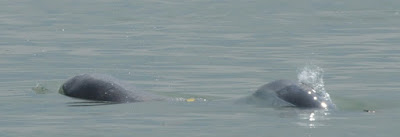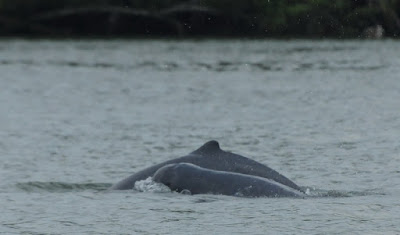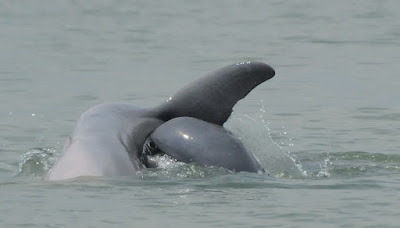The dolphins proved quite easy to see, and we saw a fair number of them - mostly in pairs - not courting couples, but (as I learned later from Dipani Sutaria, a biologist who works with the dolphins among village communities in India) mothers with their calves.
The Irrawaddy is a unusual-looking dolphin, totally lacking the typical dolphin "beak". It recalls, in some ways, a miniature version of the Beluga Whale (Delphinapterus leucas) of the far north, and was once thought to be its near relative. DNA evidence, however, suggests that is a perfectly good member of the dolphin family, perhps closest to the largest of the lot, the Killer Whale (Orcinus orca).
In some parts of their range Irrawaddy Dolphins are freshwater animals, ranging far up into river basins. In the Kuching area, however - though one will occasionally venture inland - they stay almost exclusively within the brackish waters of the estuary, usually close to shore in waters less than 10 m. deep.
Irrawaddy Dolphins are not the extroverts that some dolphins are, and most of our sightings were of dolphin backs, rolling gently just above the surface.
Notice the open blowholes in this picture!
Occasionally we were treated to a flip of their tail flukes as the dolphins dove...The Irrawaddy is a unusual-looking dolphin, totally lacking the typical dolphin "beak". It recalls, in some ways, a miniature version of the Beluga Whale (Delphinapterus leucas) of the far north, and was once thought to be its near relative. DNA evidence, however, suggests that is a perfectly good member of the dolphin family, perhps closest to the largest of the lot, the Killer Whale (Orcinus orca).
In some parts of their range Irrawaddy Dolphins are freshwater animals, ranging far up into river basins. In the Kuching area, however - though one will occasionally venture inland - they stay almost exclusively within the brackish waters of the estuary, usually close to shore in waters less than 10 m. deep.
Irrawaddy Dolphins are not the extroverts that some dolphins are, and most of our sightings were of dolphin backs, rolling gently just above the surface.
Notice the open blowholes in this picture!
...sometimes we saw them floating casually on their backs, flippers in the air...
...and, on two or three occasions, we were lucky enough to watch one "skyhop", lifting its head and forequarters out of the water like a surfacing mermaid. Kevin, who had borrowed my camera, managed to get a quick snap - distant and slightly out of focus, but evocative.
My natural assumption was that the dolphin wanted to have a look at us - but it appears that it had something quite different on its mind. If you look closely, you can see that it is spitting a stream of water out of its mouth (something I failed to notice at the time). Apparently Irrawaddy Dolphins spit like this to herd fish. The stream of water presumably confuses the fish, and may make it easier for the dolphins to snap them up.
The pairs of dolphins that we were seeing rarely seemed apart from each other. Had I known at the time that they were mothers and calves, I would have found this far less surprising!
Not only were they together, but for much of the time they actually seemed to be in contact.
This photo is the best evidence I have of what the dolphins were, in fact, doing. I thought at the time that it showed one dolphin nipping playfully at the other's flank, but when I showed it to Dipani Sutaria (at the Society for Conservation Biology conference in Auckland, some months afterwards) she identified it as something much more interesting: a mother nursing her calf. Probably some of my other pictures show the same thing, if less dramatically. At least during our visit, the estuary had become a nursery.
Of all the dolphin photos I took on our excursion, this is my favourite. It is good evidence of how fortunate we were to see these remarkable, and endangered, animals close at hand.
Over much of its range, the Irrawaddy Dolphin is in serious trouble. Pollution, coastal development, and poorly-tended fishing gear threaten them from India to Indonesia - even here, where the population is fairly large and dolphin-watching popular. Conservation and research on the Irrawaddy Dolphins of Santubong, and other coastal dolphin populations along the the Sarawak coast, is the business of the Sarawak Dolphin Project. We encountered one of their survey teams, scientists who ave been studying the dolphins in the estuary since 2008.
Only a few weeks before our trip, the results of surveys in 2008-2009 appeared in the Raffles Museum Bulletin. The paper is available online, and provides a valuable summary of what we know about Sarawak's estuarine dolphins, and about the threats facing them.























No comments:
Post a Comment